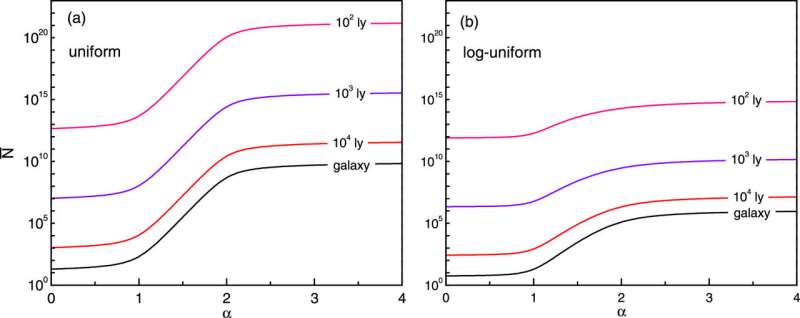This article has been reviewed according to Science X's editorial process and policies. Editors have highlighted the following attributes while ensuring the content's credibility:
fact-checked
trusted source
proofread
How long will advanced civilizations try to communicate with us?

Technosignature research is heating up, with plenty of papers speculating on the nature, and sometimes the longevity, of signals created by technically advanced extraterrestrial civilizations. While we haven't found any so far, that isn't to say that we won't, and a better understanding of what to look for would undoubtedly help.
Enter a new paper published in The Astronomical Journal by Amedeo Balbi and Claudio Grimaldi, two professors at the Universita di Roma Tor Vergata and the Ecole Polytechnique Federale de Lausanne, respectively. They have taken a statistical model to the problem of understanding how old a technosignature might be before we are likely to find it—and their answer is, surprisingly young.
We've reported before on how another recent paper thought that any civilization that created a technosignature that we can see is likely to be much older than ours. Simply put, technosignatures can last a long, long time. Over those long periods, the technosignatures can travel to places that are farther away. Given the extreme longevity of some of these civilizations, it turns out we are more likely to come across a technosignature that has been around for a very long time rather than one just created recently.
However, one big assumption in the previous paper is that the technosignature would last for extremely long periods. That assumption might not always hold, as many technosignatures have to be actively supported, such as radio signals or artificial lights on a planet. Given the active support these require, it's likely they wouldn't be supported anywhere near as long as implied by the previous paper.
Drs. Balbi and Grimaldi instead use a statistical technique to more accurately reflect what they think the actual situation in the universe would be—civilizations actively support their technosignatures for some time but let them die off once they are no longer beneficial to the civilization itself—essentially eliminating our chance to find them. From a statistical point of view, this clusters the vast majority of observable technosignatures to the far left of the x-axis, where that axis is defined as the longevity of a civilization.
We could see some obvious technosignature that have been around for billions of years and don't require any active support, such as the thermoradiation of a Dyson sphere. But it's much more likely that, if we do see one, it is actively being supported by an active civilization.
In the paper, the researchers perform a more rigorous statistical analysis, including invoking an idea known as Lindy's Law. That law is somewhat counterintuitive, as it states that the life expectancy of a technology is roughly proportional to its age. In other words, as a technology ages, its life expectancy increases. However, it has been proven in multiple scenarios and has various causes.
The impact it has on this particular analysis is clear—the probability distribution of the length of a technically advanced civilization's existence should be skewed per Lindy's Law to show that short-lived technosignatures are much more common than long-lived ones.
At the moment, this is all theoretical, and it would be interesting to see what Dr. Kipping, the author of the original paper arguing for longer-lived societies, has to say about this alternative view of the statistical treatment. Maybe it will be featured on an episode of his Cool Worlds channel soon. Until then, the hard work of SETI data collection will continue apace, and the theoreticians will continue fine-tuning their statistical models, hoping to one day catch a glimpse of something out there.
More information: Amedeo Balbi et al, Technosignatures Longevity and Lindy's Law, The Astronomical Journal (2024). DOI: 10.3847/1538-3881/ad217d
Provided by Universe Today





















